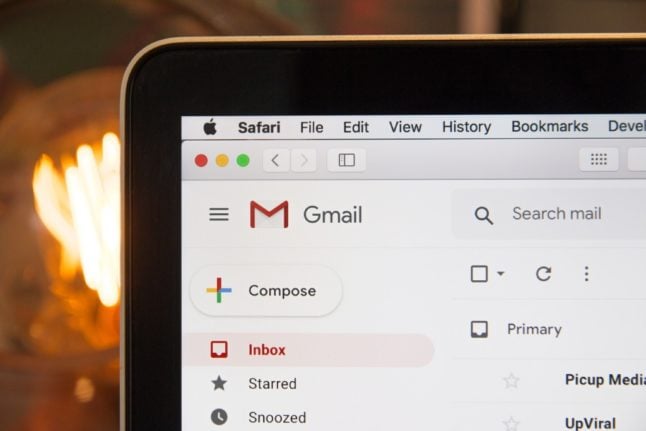EXPLAINED: How to write a formal email in Italian

Knowing how to write a polite email will make your life in Italy much easier. Here’s a quick guide to the style rules.
If you live in Italy there are countless situations in which you’re likely to find yourself having to write a formal email in Italian, such as when applying for a job or arranging a viewing for a flat.
But while you may be a master at crafting formal emails in your own language, you’re likely to struggle to do so in Italian. Even people with an excellent command of Italian, including native speakers, need to learn the style rules associated with formal writing.
READ ALSO: EXPLAINED: What is Italy’s PEC email and how do you get one?
So here’s an essential step-by-step guide to writing a formal email and getting it right every time.
Greetings
While greetings are fairly uncomplicated in English (‘Dear’ followed by the title and surname of the recipient will usually suffice), there are multiple options in Italian.
If you’re writing to someone that you’ve never met before, you’ll want to address them with either Egregio (eminent) or Spettabile (esteemed), like so:
-
- Egregio / Spettabile Dottor Rossi
- Egregia Dottoressa Rossi
Conversely, if you’re writing to someone that you’ve seen before but have no relationship with – as in you might have said hello to them but you’ve never had a conversation with them – your best option would be Gentile (courteous) or its superlative Gentilissimo (often abbreviated to Gent.mo).
Finally, the least formal option is Caro (Dear), which you should only use when writing to someone you’re already well-acquainted with (for instance, a colleague or a university tutor).
READ ALSO: How to use your Italian ID card to access official services online
Remember: these adjectives must match the recipient’s gender (e.g., you should use Gentilissima for a woman and Gentilissimo for a man).
Titles
Italians love their titles, so you should always try your best to get them right in your emails. Failure to do so might result in your recipient pointing out your mistake – which, from personal experience, is not very nice.
Here’s a list of the most common Italian titles and their abbreviations:
-
- Any man with an undergraduate or postgraduate degree, and male doctors: Dottore (Dott.)
- Any woman with an undergraduate or postgraduate degree, and female doctors: Dottoressa (Dott.ssa)
- Male professor/lecturer: Professore (Prof.)
- Female professor/lecturer: Professoressa (Prof.ssa)
- Lawyer: Avvocato (Avv.)
- Architect: Architetto (Arch.)
- Man with no degrees: Signore (Sig.) – equivalent of Mr
- Woman with no degrees: Signora (Sig.ra) – equivalent of Ms
Opening sentence
In the opening sentence, you should always state your name (Mi chiamo plus name and surname) and explain why you’re writing.
If you’re the one initiating the exchange, you can use:
-
- Le scrivo in merito a [qualcosa] (I am writing about [something])
- La contatto in riferimento a [qualcosa] (I am contacting you in regards to [something])
- La disturbo per [...] (I am troubling you to [...])

Italians love their titles, so you should always try your best to get them right in your emails. Photo by Stephen PHILLIPS via Unsplash
If you’re replying to an email instead, you could start with:
-
- In risposta alla sua precedente mail, [...] (literally, ‘in response to your email’)
As you might have noted, all of these expressions refer to the recipient via third-person pronouns (le, la). This is known as ‘forma di cortesia’ (polite form) and must be used in all formal exchanges.
READ ALSO: How to register with the anagrafe in Italy
All pronouns and adjectives referring to the recipient, and all verbs the recipient is the subject of, must be used in the third person, as in the following case:
-
- Le sarei molto grato, se mi mandasse il suo numero di cellulare.
- I’d be really grateful if you could send me your mobile number.
The above rule applies to all parts of the email, from the opening statement to the sign-off.

The third-person ‘polite form’ is an essential part of Italian formal emails. Photo by Burst via Unsplash
It’s also worth mentioning that the original forma di cortesia requires the writer to capitalise the first letter of all pronouns and adjectives referred to the recipient.
-
- La ringrazio per il Suo interesse e Le auguro una buona giornata.
- Thanks for your interest. I wish you a good day.
That said, modern Italian is gradually moving away from this practice, with capitalisation surviving in very few isolated contexts. Notably, it is advisable that you capitalise the above-mentioned forms when exchanging messages with lawyers, government officials, law enforcement authorities or high-profile public figures.
Body
Write your message in Italian much as you would a formal email in your own language. Be pithy but clear and exhaustive. Just don’t forget about the forma di cortesia.
Signing off
Once again, there are multiple ways to sign off but these are generally the safest options as they fit nicely into any type of message, regardless of its content or recipient:
-
- La ringrazio per la sua gentile attenzione / il tempo dedicatomi (Thanks for your kind attention / your time)
- Resto in attesa di un suo cortese riscontro (Kindly looking forward to your reply)
You can follow either one of the above expressions with Cordiali saluti (Kind regards) or Cordialmente (Sincerely).
Finally, as you would in other languages, end with your full name and any contact details that you might want to share with the recipient.
Comments (1)
See Also
If you live in Italy there are countless situations in which you’re likely to find yourself having to write a formal email in Italian, such as when applying for a job or arranging a viewing for a flat.
But while you may be a master at crafting formal emails in your own language, you’re likely to struggle to do so in Italian. Even people with an excellent command of Italian, including native speakers, need to learn the style rules associated with formal writing.
READ ALSO: EXPLAINED: What is Italy’s PEC email and how do you get one?
So here’s an essential step-by-step guide to writing a formal email and getting it right every time.
Greetings
While greetings are fairly uncomplicated in English (‘Dear’ followed by the title and surname of the recipient will usually suffice), there are multiple options in Italian.
If you’re writing to someone that you’ve never met before, you’ll want to address them with either Egregio (eminent) or Spettabile (esteemed), like so:
-
- Egregio / Spettabile Dottor Rossi
- Egregia Dottoressa Rossi
Conversely, if you’re writing to someone that you’ve seen before but have no relationship with – as in you might have said hello to them but you’ve never had a conversation with them – your best option would be Gentile (courteous) or its superlative Gentilissimo (often abbreviated to Gent.mo).
Finally, the least formal option is Caro (Dear), which you should only use when writing to someone you’re already well-acquainted with (for instance, a colleague or a university tutor).
READ ALSO: How to use your Italian ID card to access official services online
Remember: these adjectives must match the recipient’s gender (e.g., you should use Gentilissima for a woman and Gentilissimo for a man).
Titles
Italians love their titles, so you should always try your best to get them right in your emails. Failure to do so might result in your recipient pointing out your mistake – which, from personal experience, is not very nice.
Here’s a list of the most common Italian titles and their abbreviations:
-
- Any man with an undergraduate or postgraduate degree, and male doctors: Dottore (Dott.)
- Any woman with an undergraduate or postgraduate degree, and female doctors: Dottoressa (Dott.ssa)
- Male professor/lecturer: Professore (Prof.)
- Female professor/lecturer: Professoressa (Prof.ssa)
- Lawyer: Avvocato (Avv.)
- Architect: Architetto (Arch.)
- Man with no degrees: Signore (Sig.) – equivalent of Mr
- Woman with no degrees: Signora (Sig.ra) – equivalent of Ms
Opening sentence
In the opening sentence, you should always state your name (Mi chiamo plus name and surname) and explain why you’re writing.
If you’re the one initiating the exchange, you can use:
-
- Le scrivo in merito a [qualcosa] (I am writing about [something])
- La contatto in riferimento a [qualcosa] (I am contacting you in regards to [something])
- La disturbo per [...] (I am troubling you to [...])

If you’re replying to an email instead, you could start with:
-
- In risposta alla sua precedente mail, [...] (literally, ‘in response to your email’)
As you might have noted, all of these expressions refer to the recipient via third-person pronouns (le, la). This is known as ‘forma di cortesia’ (polite form) and must be used in all formal exchanges.
READ ALSO: How to register with the anagrafe in Italy
All pronouns and adjectives referring to the recipient, and all verbs the recipient is the subject of, must be used in the third person, as in the following case:
-
- Le sarei molto grato, se mi mandasse il suo numero di cellulare.
- I’d be really grateful if you could send me your mobile number.
The above rule applies to all parts of the email, from the opening statement to the sign-off.

It’s also worth mentioning that the original forma di cortesia requires the writer to capitalise the first letter of all pronouns and adjectives referred to the recipient.
-
- La ringrazio per il Suo interesse e Le auguro una buona giornata.
- Thanks for your interest. I wish you a good day.
That said, modern Italian is gradually moving away from this practice, with capitalisation surviving in very few isolated contexts. Notably, it is advisable that you capitalise the above-mentioned forms when exchanging messages with lawyers, government officials, law enforcement authorities or high-profile public figures.
Body
Write your message in Italian much as you would a formal email in your own language. Be pithy but clear and exhaustive. Just don’t forget about the forma di cortesia.
Signing off
Once again, there are multiple ways to sign off but these are generally the safest options as they fit nicely into any type of message, regardless of its content or recipient:
-
- La ringrazio per la sua gentile attenzione / il tempo dedicatomi (Thanks for your kind attention / your time)
- Resto in attesa di un suo cortese riscontro (Kindly looking forward to your reply)
You can follow either one of the above expressions with Cordiali saluti (Kind regards) or Cordialmente (Sincerely).
Finally, as you would in other languages, end with your full name and any contact details that you might want to share with the recipient.
Join the conversation in our comments section below. Share your own views and experience and if you have a question or suggestion for our journalists then email us at [email protected].
Please keep comments civil, constructive and on topic – and make sure to read our terms of use before getting involved.
Please log in here to leave a comment.